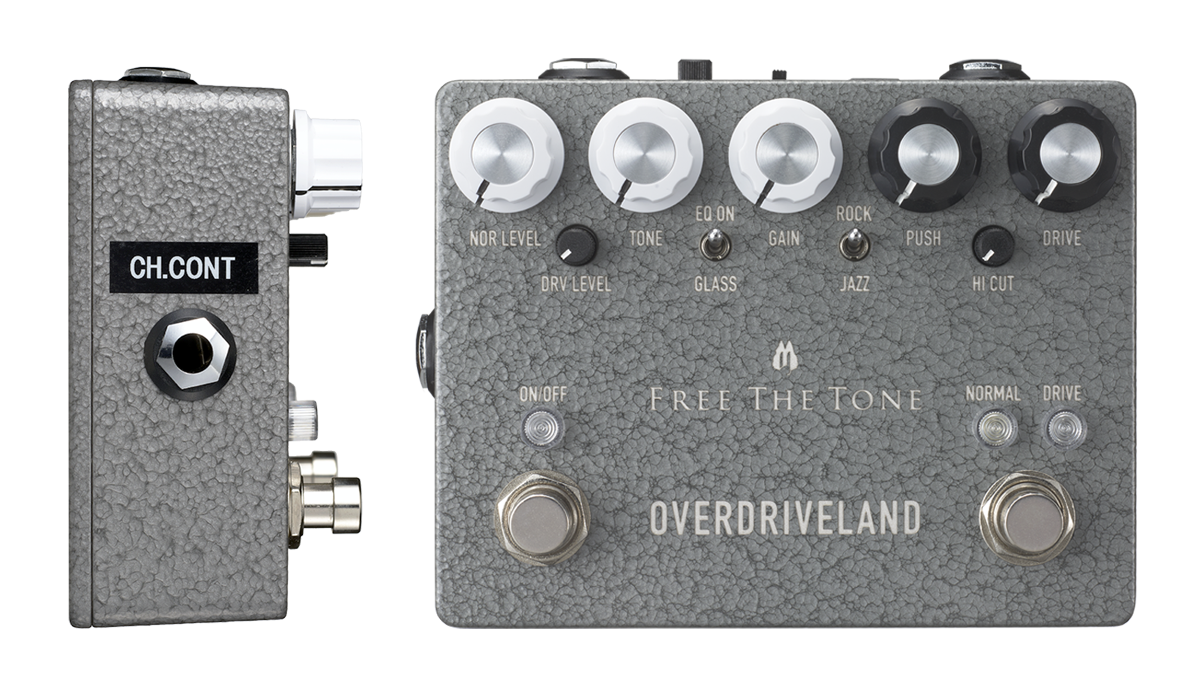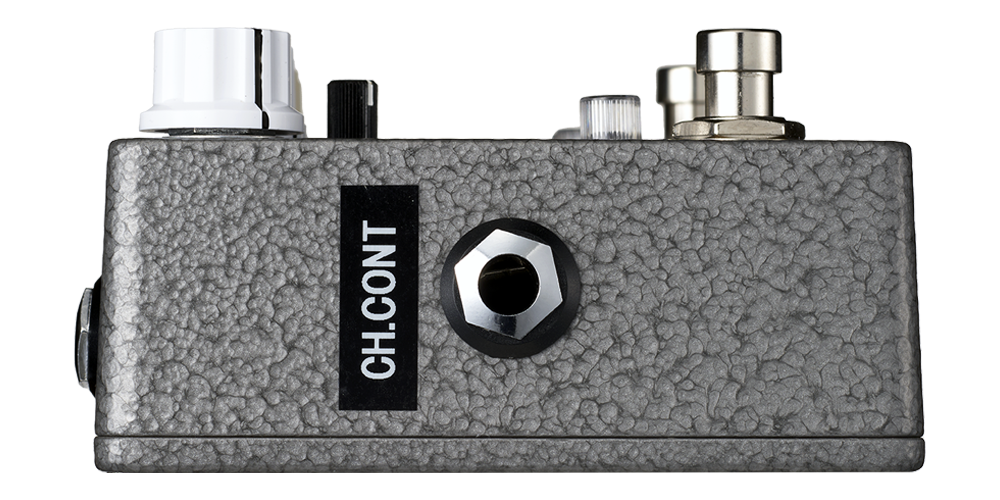
| Model | OVERDRIVELAND / ODL-1A-CS |
|---|---|
| Type | OVERDRIVE |
| Manual |
OVERDRIVELAND / ODL-1A-CS Manual |
-
Price : Yen 59,000.- plus shipping
The ODL-1A-CS is a modified version of the ODL-1-CS that maintains its original sound while adding a channel control terminal, allowing users to switch between NORMAL and DRIVE channels using an external switch.

Background of Development:
FREE THE TONE's founder and designer, Yuki Hayashi, amassed over 20 years of experience in maintaining and repairing DUMBLE amplifiers and was a proud owner of multiple DUMBLE amps himself. DUMBLE amplifiers are known for their distinctive harmonics, which can make even clean sounds seem slightly distorted. Furthermore, the drive sound of a DUMBLE amp responds to a guitarist's playing as if the amplifier itself possesses intention. It was this desire to capture this unique feel and translate it into a pedal-sized overdrive pedal that sparked the development process.


Development Story:
The DUMBLE amplifier has been a beloved choice for numerous renowned guitarists such as Larry Carlton, Robben Ford, Eric Johnson, Stevie Ray Vaughan, and John Mayer. They have been captivated by its exceptional sensitivity to the signal level from the guitar and the distinctive, thick, and rich harmonics that are unique to DUMBLE amplifiers. Through an American guitar tech intermediary, I've had several exchanges with Mr. DUMBLE himself. He inquired about my primary guitar and the type of music I mainly played when crafting an amp, emphasizing that he used the guitarist's main instrument to fine-tune each amp. It truly showcases the craftsmanship of DUMBLE.

For the development of OVERDRIVELAND, I drew inspiration from the later model of the OVERDRIVE SPECIAL. In this model, the 'OVERDRIVE SPECIAL' label features digital-style characters. I find this model to be the most fitting for contemporary music, offering a robust rock-oriented sound.
In order to imbue pedal-style overdrive with DUMBLE amplifier-like characteristics, I translated various ideas into circuitry and conducted numerous experiments. For the fundamental circuit (the NORMAL channel of OVERDRIVELAND), I decided not to use clipping diodes or LEDs. The reason for this choice was that using clipping diodes or LEDs made it challenging to achieve the intended harmonic components.
In order to imbue pedal-style overdrive with DUMBLE amplifier-like characteristics, I translated various ideas into circuitry and conducted numerous experiments. For the fundamental circuit (the NORMAL channel of OVERDRIVELAND), I decided not to use clipping diodes or LEDs. The reason for this choice was that using clipping diodes or LEDs made it challenging to achieve the intended harmonic components.
When I increase the 'GAIN' on the NORMAL channel, the sound gradually starts to distort. However, even if I lower the 'GAIN' knob below the 12 o'clock position, I can still sense the presence of rich harmonic components within the clean sound. This is what allows OVERDRIVELAND's harmonics to be the secret to enjoying clean sounds while playing

After creating the basic normal channel circuit, I developed a dedicated drive circuit module to finely respond to the signal output from the guitar. It took me some time to complete this module, but it turned out to be a highly refined one. In the custom shop version and the standard version, different modules are used to bring out their respective sound characters.
For the custom shop version, custom modules are used with different components than the standard version in order to respond more sensitively to input signals.
For the custom shop version, custom modules are used with different components than the standard version in order to respond more sensitively to input signals.
Next, I tackled the challenge of controlling the strength of the sound, akin to a DUMBLE amp... If the sound is too overpowering, it might not fit well with certain types of music. It would be ideal if I could adjust this strength and perceived volume.
I experimented with various methods, whether adding a different circuit before or after the normal channel circuit or inserting a circuit in between. I also took inspiration from the sound and equipment connections used by Brian May and Gary Moore.
Ultimately, I added a drive circuit that uses a dedicated module before the normal channel circuit and adopted a method to adjust how much signal is sent to the input stage of the normal channel. By adjusting this signal level, I can control the perceived volume level. This is the role of the "PUSH" knob.
To finely respond to the input level, I not only developed a dedicated drive circuit module but also designed a new power supply circuit. In order to use OVERDRIVELAND with a standard DC9V power source, I incorporated a power supply boost circuit that can increase the supply voltage to the analog circuit from DC9V to a maximum of DC19V. By adjusting the voltage of this boost power supply circuit, the dynamic range of OVERDERIVELAND and the clipping point of the signal can be altered. Lowering the voltage reduces the level of the clipping point, resulting in long sustain. Conversely, increasing the voltage raises the level before reaching the clipping point, giving a sound that really cuts through. This feature is highly effective and can produce different sounds as if there were entirely separate overdrive pedals available.
By adjusting the harmonic components of the input guitar signal, OVERDRIVELAND offers a unique sound that balances well across all strings, from the 1st to the 6th (or 7th) string. It becomes an instrument that can expand the possibilities of expression.
Please feel free to explore these possibilities with OVERDRIVELAND.
I experimented with various methods, whether adding a different circuit before or after the normal channel circuit or inserting a circuit in between. I also took inspiration from the sound and equipment connections used by Brian May and Gary Moore.
Ultimately, I added a drive circuit that uses a dedicated module before the normal channel circuit and adopted a method to adjust how much signal is sent to the input stage of the normal channel. By adjusting this signal level, I can control the perceived volume level. This is the role of the "PUSH" knob.
To finely respond to the input level, I not only developed a dedicated drive circuit module but also designed a new power supply circuit. In order to use OVERDRIVELAND with a standard DC9V power source, I incorporated a power supply boost circuit that can increase the supply voltage to the analog circuit from DC9V to a maximum of DC19V. By adjusting the voltage of this boost power supply circuit, the dynamic range of OVERDERIVELAND and the clipping point of the signal can be altered. Lowering the voltage reduces the level of the clipping point, resulting in long sustain. Conversely, increasing the voltage raises the level before reaching the clipping point, giving a sound that really cuts through. This feature is highly effective and can produce different sounds as if there were entirely separate overdrive pedals available.
By adjusting the harmonic components of the input guitar signal, OVERDRIVELAND offers a unique sound that balances well across all strings, from the 1st to the 6th (or 7th) string. It becomes an instrument that can expand the possibilities of expression.
Please feel free to explore these possibilities with OVERDRIVELAND.
How to Use and Features:

OVERDRIVELAND consists of two main sections. The first is the Normal Channel circuit, through which the signal passes when the Normal Channel is selected. This circuit includes the Tone circuit (including the EQ ON/GLASS switch) and Gain characteristics adjustment with the ROCK/JAZZ switch.
The second section is the Drive circuit. When the Drive Channel is selected, the signal passes through this Drive circuit before flowing into the Normal Channel circuit.
The second section is the Drive circuit. When the Drive Channel is selected, the signal passes through this Drive circuit before flowing into the Normal Channel circuit.

The Normal Channel features the "EQ ON/GLASS" and "ROCK/JAZZ" switches to help set the foundation for your sound.
The "EQ ON/GLASS" switch controls the equalization function of the Normal Channel. When set to "EQ ON," the "TONE" circuit is activated, allowing you to shape your tone. Selecting "GLASS" bypasses the "TONE" circuit, giving you a glassy tone reminiscent of turning on the Bright switch on a Blackface Fender Vibroverb.
The "ROCK/JAZZ" switch adjusts the frequency response and gain settings of the Normal Channel. The "ROCK" side is designed for shaping your sound with increased gain, while slightly reducing the gain in the low-frequency range to prevent excessive low-end volume that can cause the amp's input stage to distort. The "JAZZ" side, on the other hand, lowers the overall gain and is designed to bring out the richness in the low-frequency range.
The "EQ ON/GLASS" switch controls the equalization function of the Normal Channel. When set to "EQ ON," the "TONE" circuit is activated, allowing you to shape your tone. Selecting "GLASS" bypasses the "TONE" circuit, giving you a glassy tone reminiscent of turning on the Bright switch on a Blackface Fender Vibroverb.
The "ROCK/JAZZ" switch adjusts the frequency response and gain settings of the Normal Channel. The "ROCK" side is designed for shaping your sound with increased gain, while slightly reducing the gain in the low-frequency range to prevent excessive low-end volume that can cause the amp's input stage to distort. The "JAZZ" side, on the other hand, lowers the overall gain and is designed to bring out the richness in the low-frequency range.

When you select the Drive Channel in OVERDRIVELAND, the Drive circuit is added in front of the Normal Channel circuit. In other words, from the input side, the signal flows in the following order: Drive circuit, Normal Channel circuit, and then the output circuit. The Drive circuit is equipped with a "HI-CUT" filter circuit, making it easy to adjust the high-frequency characteristics. Additionally, the "PUSH" control adjusts the signal level sent from the Drive circuit to the Normal Channel, allowing you to control the perceived volume level. You can also adjust the volume when the Drive Channel is selected using the "DRV LEVEL" knob.
Power Supply:

OVERDRIVELAND is equipped with a power supply switching feature. When you select DC9V, power is supplied to the audio circuit from the power supply connected to the DC jack. When you select "Int.PS (STANDARD)" or "VARI (CUSTOM SHOP)," the power supply is connected to the internal boost circuit, and power is supplied to OVERDRIVELAND's audio circuit through this boost circuit. The specifications differ between the STANDARD version and the CUSTOM version.

You can smoothly adjust the voltage supplied to the audio circuit from DC10V to 19V. By altering the power supply voltage, the clipping point changes, resulting in dramatic variations in the drive sound. While enjoying the changes in sound, try finding the voltage that matches your personal preference.
<Note>
The ODL-1A-CS cannot be operated on batteries due to its high current consumption.
Please use it by connecting an AC adapter to the DC9V input terminal. You can also use an AC adapter with a stabilized DC9V output and center-negative polarity. As a large current flows when powering on, please use an AC adapter capable of supplying 200mA or more.
<Note>
The ODL-1A-CS cannot be operated on batteries due to its high current consumption.
Please use it by connecting an AC adapter to the DC9V input terminal. You can also use an AC adapter with a stabilized DC9V output and center-negative polarity. As a large current flows when powering on, please use an AC adapter capable of supplying 200mA or more.

<About CH.CONT Terminal>
By connecting an ARC series control terminal or latch-type footswitch to the CH.CONT terminal, you can control switching between NORMAL and DRIVE channels without pressing the unit's footswitch.
*When a plug is inserted into the CH.CONT terminal, switching between NORMAL and DRIVE channels using the unit's footswitch will be disabled.
*When a plug is inserted into the CH.CONT terminal, switching between NORMAL and DRIVE channels using the unit's footswitch will be disabled.

